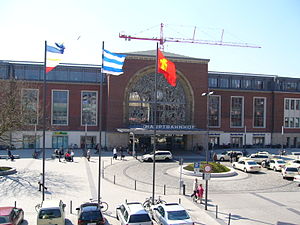Kiel Hauptbahnhof
| Terminus | |

Main entrance on the north side
|
|
| Location | Sophienblatt 25-27, Kiel, Schleswig-Holstein Germany |
| Coordinates | 54°18′53″N 10°07′54″E / 54.314821°N 10.131798°ECoordinates: 54°18′53″N 10°07′54″E / 54.314821°N 10.131798°E |
| Line(s) | |
| Platforms | 8 |
| Construction | |
| Architectural style | Baroque Revival |
| Other information | |
| Station code | 3174 |
| DS100 code | AK |
| IBNR | 8000199 |
| Category | 2 |
| Website | www.bahnhof.de |
| History | |
| Opened | 1899 |
Kiel Hauptbahnhof is the main railway station in the northern German city of Kiel. It consists of eight rail tracks, all of which are electrified, and is a hub for train services to nearby towns such as Plön and Eckernförde.
With 25,000 daily passengers and visitors to Kiel Hauptbahnhof, it is the second busiest railway station in Schleswig-Holstein after Lübeck Hauptbahnhof. The area around the station is the busiest place in Kiel. More than 100,000 people daily use the bus station, the railway station and the station forecourt.
The station is the starting point of lines to Hamburg, Lübeck, Flensburg and Husum. It is located directly on Kieler Förde. The ferry terminal for Oslo and Gothenburg is a few hundred metres away.
Kiel Hauptbahnhof is built as a railway terminus and has a three-aisled train shed, which is 121 metres long and 55 m wide.
Kiel's first railway station was built between 1843 and 1846 at Ziegelteich, about 500 m north of the current location. This station was unable to cope with the growing traffic, especially after the declaration of the Reichskriegshäfen ("Imperial War Harbours") in Kiel in 1871. The current location was selected for its improved access to the port by road. Construction began in 1895.
The western part of the six-track terminal station was completed and opened in 1899. Trains continued to run in the meantime to the old station through a gap in the east wing. After the opening of the new station, operations to the old station were abandoned and the east wing was completed in 1900. The old station was demolished in 1902. On the east side of the entrance building were the imperial steps (Kaisertreppe), which together with a curved driveway provided the shortest possible route to the harbour basin where the imperial yacht was berthed. The final completion of the west wing and the platform hall lasted until 1911 because, among other things, the city monastery and a poorhouse on Sophienblatt, had to be demolished.
...
Wikipedia
